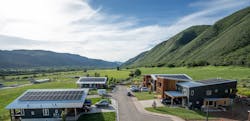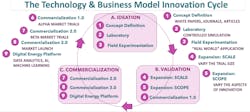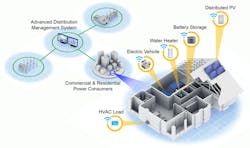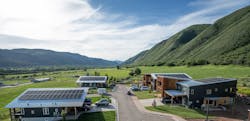The Energy Transition: Technology and Business Model Innovation Path
Halfway through 2021, we're seeing more and more evidence that a transformation — "a thorough or dramatic change" — of our global energy economy and ecosystem is underway. This article is the first of many in a new series on what's come to be called The Energy Transition.
A transition — "moving from one state to another" — is the path taken in a transformation. I learned this distinction years ago when talking to utility executives about business transformation. They preferred to talk about a managed transition. They told me it was more practical because it involved defining the achievable steps they could take without turning everything upside down.
Years ago — after those conversations — I developed a model for Managed Transition Planning, which seems very relevant today. In this new T&D World series, we'll develop a framework to help evaluate and understand The Energy Transition. We'll define priorities on the transformation path, showcase examples of innovative approaches to transition, and highlight transition milestones for efficient change.
An Overview
As we elaborate on the transformation vision, we'll come back again and again to four drivers (all beginning with D):
1. Decarbonization: We'll have answered the imperative to reduce carbon emissions — we'll no longer rely on burning fossil fuels.
2. Decentralization: We'll have embraced decentralized energy resources (DERs), moving from a few remote, large generation points connected to the grid to millions of smaller site-based systems that may or may not be grid-connected.
3. Digitalization: We'll have harnessed digital technologies, mastering the world of sensors and data analytics, artificial intelligence (AI), machine learning, and the internet of things (IoT).
4. Democratization: The energy system will no longer be confined to insider subject matter experts but will be opened up so that any interested and motivated stakeholder can actively engage and make a difference.
Our discussion will focus on six other key aspects of transition:
1. Climate Change Mitigation and Adaptation: We're tasked now with both slowing down carbon emissions and reordering our lives and systems to adapt to more extreme weather and other consequences.
2. Resilience: Recovering rapidly from disruption will become increasingly important for both electric utilities and residential, commercial, and industrial consumers.
3. Transportation and Building Electrification: Adding eMobility and Grid Interactive Efficient Buildings (GEBs) to our systems will be critical to address these principal sources of carbon emissions.
4. Grid Modernization: Our electric grid evolved over 100 years to its current state. Modernizing this infrastructure will be driven by digitalization and data from sensors that promote more efficient and resilient operations in both the field and the enterprise.
5. Community Activation: Beyond what and how we take steps in this transition, it will be critical to answer the who question, finding inclusive ways to educate stakeholders and work with communities to achieve social and environmental justice.
6. Technology and Business Model Innovation: Innovation, key to new solutions and approaches, will come from steady evolution as well as disruptive bursts.
In our analysis of the Energy Transition, we'll see issues from this list over and over again. To better understand innovation in practice, as I wrote this article, I created a general model for innovation-driven transition and transformation, the Technology and Business Model Innovation Cycle as described in the graphic below.
No doubt this chain of value-added activity looks familiar to readers. I made this supply chain model explicit to provide a reference point as we evaluate innovation and transition. We can use this supply chain model to track the progress of innovation and better understand the lessons learned that promote success and the extraneous factors that inevitably arise to constrain transition and become barriers to transformation. Because we'll innovate in iterative fashion to integrate new technologies and ideas, collecting data and using data analytics tools, including AI, I present this model as a cycle, rather than a linear supply chain, to be repeated over time.
For this two-part article, we'll use this model to examine DER integration, a key problem throughout the electricity sector. In particular, we'll focus on a set of innovators who are seeking practicable ways to scale grid-integrated DER. Scaling and acceleration will be critical as DER becomes more widely accepted, in particular because the power grid was designed for large central generation, long distance transmission, and local one-way distribution — not for DER integration. As falling prices and increasing functionality make widespread adoption of DER technologies and solutions a foregone conclusion, we'll shift to scaling challenges. For DER to scale rapidly, we'll need to find new ways to adapt our historic grid paradigm and to re-evaluate core assumptions on how the grid should operate.
Part 1: The Innovators
We begin our story in Part 1 by introducing some key pioneers who have long been working on this monumental challenge and have come together recently to move beyond concept definition (1) and lab simulations (2) to collaborate on a field trial (3) and expand that trial in scope (4).
David Chassin, PhD: Dr. Chassin, an engineer by training, now serves as manager and chief scientist of GISMo — Grid Integration, Systems, and Mobility Development — a multi-disciplinary research group that's part of the Applied Energy Division in the SLAC National Accelerator Laboratory at Stanford, one of the 17 National Energy Labs under the DOE. Prior, Chassin had a long career as staff scientist at Pacific Northwest National Laboratory (PNNL), where he published more than 150 articles, white papers, and so forth.
Lynne Kiesling, PhD: Dr. Kiesling is an economist with deep experience in regulation, market design and digitization and smart grid technologies in the electricity industry. She recently accepted a position as research professor and co-director, Institute for Regulatory Law & Economics IRLE at the University of Colorado Denver. Previously, Kiesling was a faculty member and served as a faculty affiliate in the Wilton E. Scott Institute for Energy Innovation at Carnegie Mellon University.
Bryan Hannegan, PhD: Dr. Hannegan, a climate scientist, innovator, and thought leader, served as associate lab director at the DOE's National Renewable Energy Lab (NREL), where he co-founded the DOE's Grid Modernization Initiative (GMI). He also launched the Energy Systems Integration Facility (ESIF) at the NREL, which enables distribution grid experimentation. Before the NREL, Hannegan held senior leadership roles in energy at the EPRI, the White House, and the U.S. Senate.
Convergence
I had the opportunity last month to sit down with Hannegan, who explained, "I'm founding director of the new Energy Systems Integration Division at the NREL, which was specifically focused on the challenge of integrating clean energy technologies into the existing energy system."
From that start at the NREL, contributors from multiple DOE labs came together in 2013 on what came to be called the DOE's Grid Modernization Initiative (GMI), which Hannegan ran along with the PNNL's Carl Imhoff. This initiative proved critical to coordinate activities among the different labs, highlighting the unique strengths of each lab and becoming a department-wide undertaking.
Four years ago, Hannegan stepped out of his role as an insider at the NREL to take the reins at Holy Cross Energy, the Glenwood Springs-based electric cooperative with a territory that includes Aspen and Vail in the Rockies. A climate scientist, Hannegan created a "Journey to 100%" plan at Holy Cross, setting a goal to fully source clean energy by 2030. It's off to a good start. The Smart Energy Power Alliance (SEPA) named Holy Cross Energy 2020 Electric Cooperative of the Year.
Lab Simulation
A key contributor to GMI was ARPA-E, which brought in its NODES Project. NODES stands for Network Optimized Distributed Energy Systems. NODES demonstrated how to control and manage multiple numbers of DER to benefit both consumers and the grid, which the NREL adopted to create a "distribution grid in a box." Such lab simulation allowed new ideas to be tested as a safer alternative to applying them directly in real-world situations, interconnected on the grid.
Within NODES, the team at the NREL focused on the challenge of scale and utility control, ultimately developing algorithms and software for what they called an autonomous energy grid(AEG) to address the vexing challenge of balancing variable energy generation with consumers' load patterns.Field Testing
Luckily for the rest of us, these tools and this experience proved valuable after Hannegan took the reins at Holy Cross Energy. As Roman philosopher Seneca famously once said, "Luck is what happens when preparation meets opportunity," and with Hannegan at the helm, this project seemed destined to come together in one way or another.
The local Habitat for Humanity chapter approached Holy Cross about the Basalt Vista affordable housing project in Basalt, Colorado. In response to a request for a permit for a natural gas line, the town asked Holy Cross about an all-electric alternative. The utility team recognized that the distribution feeder in question was the same feeder for which Holy Cross had previously provided load data to the NREL's NODE project. They decided to use the opportunity to conduct a field test of their lab results, focusing on four houses in the Basalt Vista Project.
Expansion: SCALE
This Holy Cross project had been developed using equipment provided by the utility and software tools to assess grid control of DER. But as DERs reach commercial scale with new technology capabilities and lower pricing, a utility's budget and capabilities will face limits. Market-based systems can go beyond such limitations.
Chassin and Kiesling, with a shared history of finding market-based solutions to DER scaling, saw an opportunity to expand the original project scope to test their ideas on market coordination of DER integration. Under development in a project at GISMo, Transactive Energy Service System (TESS) is a platform approach to address the fundamental obstacles to realizing the vision of transactive energy, long a concept whose time it seems has always been years away from reality.
Part 2
With that, I'll pause. This is such a fascinating story that it's been a challenge to introduce it in the space allowed here. I hope that you've already clicked on the links to do further reading, or that you'll go back to do so. We'll pick up the story in the next article, Part 2, going deeper into the origins of innovative thought, the challenges of DER integration and grid modernization, and the TESS vision and its implications to dramatically scale DER and enable critical transportation and building electrification and grid modernization.
John Cooper, Founder and CEO of NXT NRG, is an energy entrepreneur and recognized innovator in the electricity sector. Based in Austin, TX, NXT NRG provides services that integrate decarbonization with resilience, energy self-sufficiency, transportation & building electrification, and data/digitalization. John is a widely published author and public speaker (The Advanced Smart Grid: Edge Power Driving Sustainability, 2011 1st Ed, 2014 2nd Ed). John has an MBA and a BA in Government with honors from the University of Texas at Austin
About the Author
John Cooper
John Cooper, Founder and CEO of NXT NRG, is an energy entrepreneur and recognized innovator in the electricity sector. Based in Austin, TX, NXT NRG provides services that integrate decarbonization with resilience, energy self-sufficiency, transportation & building electrification, and data/digitalization. John is a widely published author and public speaker (The Advanced Smart Grid: Edge Power Driving Sustainability, 2011 1st Ed, 2014 2nd Ed). John has an MBA and a BA in Government with honors from the University of Texas at Austin




